
TNU Journal of Science and Technology
229(03): 176 - 184
http://jst.tnu.edu.vn 176 Email: jst@tnu.edu.vn
ROLES OF ENTREPRENEURIAL MINDSET AND BUSINESS MODEL
INNOVATION TO PRODUCT INNOVATION OF TECH-BASED FIRMS
Nguyen Thi Hanh*, Nguyen Phuong Hoa
Foreign Trade University
ARTICLE INFO
ABSTRACT
Received:
22/12/2023
This study is designed to validate the impact of entrepreneurial mindset
on product innovation outcomes in technology-based enterprises while
concurrently examining the mediating influence of business model
innovation. Anchored in the opportunity innovation theory, the model
and research hypotheses underwent empirical testing through a structured
questionnaire survey conducted in technology-based businesses across
Vietnam. The dataset, derived from 163 valid responses obtained from
mid to senior-level managers, facilitated a robust analysis. Employing a
partial least squares structural equation modeling approach, the study
meticulously investigates the managerial interplay among entrepreneurial
mindset, business model innovation, and product innovation outcomes.
The results unequivocally demonstrate a positive influence of
entrepreneurial mindset on product innovation, with business model
innovation playing a partial mediating role in this relationship. This
research underscores the pivotal roles played by entrepreneurial mindset
and business model innovation in shaping product innovation outcomes
within technology-based enterprises in developing nations. Furthermore,
these businesses are encouraged to implement the research findings for
practical application actively.
Revised:
02/02/2024
Published:
02/02/2024
KEYWORDS
Entrepreneurial mindset
Product innovation
New product development
Business model innovation
Tech-based firms
VAI TRÒ CỦA TƯ DUY KHỞI NGHIỆP VÀ ĐỔI MỚI MÔ HÌNH KINH DOANH
ĐẾN KẾT QUẢ ĐỔI MỚI SẢN PHẨM CỦA DOANH NGHIỆP
DỰA TRÊN CÔNG NGHỆ
Nguyễn Thị Hạnh*, Nguyễn Phương Hoa
Trường Đại học Ngoại Thương
THÔNG TIN BÀI BÁO
TÓM TẮT
Ngày nhận bài:
22/12/2023
Nghiên cứu nhằm kiểm chứng vai trò của Tư duy khởi nghiệp tới kết quả
đổi mới sản phẩm của doanh nghiệp công nghệ, đồng thời xem xét vai
trò trung gian của đổi mới mô hình kinh doanh. Dựa trên lý thuyết đổi
mới cơ hội, mô hình và giả thuyết nghiên cứu được kiểm chứng thông
qua khảo sát bảng hỏi có cấu trúc tại các doanh nghiệp công nghệ Việt
Nam. Tập dữ liệu bao gồm 163 câu trả lời hợp lệ của các nhà quản lý cấp
trung và quản lý cấp cao. Nghiên cứu sử dụng phương pháp mô hình cấu
trúc bình phương tối thiểu từng phần để kiểm tra mối quan hệ nhân quả
giữa tư duy khởi nghiệp, đổi mới mô hình kinh doanh và kết quả đổi mới
sản phẩm. Kết quả cho thấy tư duy khởi nghiệp có ảnh hưởng tích cực
đến đổi mới sản phẩm và đổi mới mô hình kinh doanh có vai trò trung
gian một phần đối với mối quan hệ trên. Nghiên cứu khẳng định vai trò
của tư duy khởi nghiệp và đổi mới mô hình kinh doanh tới kết quả đổi
mới sản phẩm trong các doanh nghiệp công nghệ ở các nước đang phát
triển. Bên cạnh đó, các doanh nghiệp công nghệ cũng có thể áp dụng kết
quả nghiên cứu này vào thực tiễn.
Ngày hoàn thiện:
02/02/2024
Ngày đăng:
02/02/2024
TỪ KHÓA
Tư duy khởi nghiệp
Đổi mới sản phẩm
Phát triển sản phẩm
Đổi mới mô hình kinh doanh
Doanh nghiệp dựa trên công
nghệ
DOI: https://doi.org/10.34238/tnu-jst.9464
* Corresponding author. Email: hanhnt@ftu.edu.vn

TNU Journal of Science and Technology
229(03): 176 - 184
http://jst.tnu.edu.vn 177 Email: jst@tnu.edu.vn
1. Introduction
Understanding how tech-based firms navigate and drive innovation is crucial in an era of rapid
technological advancements. Product innovation, a cornerstone for these companies, is crucial in
sustaining competitiveness and meeting evolving consumer demands [1]. By delving into this
research, we aim to uncover the underlying mechanisms contributing to successful product
innovation in tech-based firms. This research explores the role of an entrepreneurial mindset,
which fosters a culture of creativity and risk-taking, and business model innovation, which can
reshape the foundations of these firms' operations. The insights from this research contribute to
academic knowledge and provide practical implications for tech-based firms aiming to thrive in a
dynamic and ever-changing technological landscape.
Existing research on product innovation in tech-based firms underscores innovation's dynamic
and multifaceted nature in the rapidly evolving technology sector [2]. Scholars have explored
various dimensions, including the pivotal role of entrepreneurial mindset and business model
innovation in shaping product innovation outcomes. Entrepreneurial mindset within tech-based
firms has been identified as a catalyst for creativity, risk-taking, and adaptability, fostering an
environment conducive to groundbreaking product development [3]. Additionally, researchers
have investigated the mediating role of business model innovation, recognizing its significance in
redefining how these firms operate and bring products to market [4]. Overall, the existing body of
research provides valuable insights into the complex dynamics of product innovation in tech-
based firms, contributing to theoretical advancements and practical implications for firms
navigating the intricacies of the technology-driven landscape [5].
While existing research has delved into various aspects of product innovation in tech-based
firms, a notable research gap centres around the nuanced interactions between entrepreneurial
mindset, business model innovation, and product innovation outcomes [6], [7]. While studies
acknowledge the individual impacts of entrepreneurial mindset and business model innovation,
there is a need for more comprehensive investigations into how these factors collaboratively
influence the innovation landscape within tech-based firms. Moreover, more attention should be
given to exploring these dynamics in the context of developing countries, such as Vietnam.
Understanding the special challenges and opportunities faced by tech-based firms in these
settings is crucial for tailoring effective strategies that foster innovation [8]. Additionally, there
needs to be more research explicitly focusing on the practical implementation of findings,
providing actionable insights for firms aiming to enhance their product innovation capabilities.
Future research can contribute significantly to refining theoretical frameworks, guiding
managerial practices, and fostering a more holistic understanding of the intricate relationships
shaping product innovation in tech-based firms by addressing these gaps. Studies highlight the
interplay between these factors, emphasizing the need for a holistic understanding of the
innovation process. The role of leadership, organizational culture, and strategic decision-making
has also been scrutinized to comprehend how these elements influence product innovation
performance [9]. Furthermore, the research delves into the challenges and opportunities presented
by technological disruptions, considering factors such as market dynamics, competition, and the
integration of emerging technologies. This paper contains four main parts; following this
introduction are methodology, results and discussion. The final part mentions implementation in
both academic and practical approaches.
2. Methodology
2.1. The research model and proposed hypothesis
This research examines the effect of entrepreneurial mindset and business model innovation
on product innovation performance. The proposed hypotheses are as follows:
H1: Product innovation is positively impacted by an entrepreneurial mindset.

TNU Journal of Science and Technology
229(03): 176 - 184
http://jst.tnu.edu.vn 178 Email: jst@tnu.edu.vn
H2: Entrepreneurial mindset has a positive effect on business model innovation.
H3: Business model innovation has a positive effect on product innovation.
H4: Business model innovation has a mediating role in the relationship between
entrepreneurship mindset and product innovation.
Figure 1. The research model
Figure 1 proposes the role of the entrepreneurial mindset and business model innovation on
product innovation of tech-based firms.
2.2. Measurement scale
The research paper employed PLS-SEM (a partial least square equation model) to examine the
proposed hypothesis. A five-point Likert scale assessed the degree of EM-entrepreneurial
mindset, BMI-business model innovation and PI-product innovation. The entrepreneurial mindset
has nine items adopted and modified by Ferreras-Méndez et al. [10]. Business model innovation
scales have six items and were adapted from Clauss [11] and Bouncken & Fredrich [12]. Product
innovation has six items and was adapted and validated by Nakata & Hwang [13]. Table 1 shows
the measurement scale of each variable.
Table 1. Measurement scale items for variables
Item code
Item description
Source
Entrepreneurial mindset
EM1
Our company emphasises R&D and technical innovation instead of validating actual products.
[10]
EM2
Our company has to develop many new lines of products/services.
EM3
We often change products/services radically compared to incremental change.
EM4
We typically adopt a very competitive.
EM5
We often introduce new products/services or operating techniques compared to competitors.
EM6
We typically adopt a very competitive.
EM7
We often aim for high-risk projects with high potential returns.
EM8
We use strong, bold and wide-ranging acts in the external environment to achieve our goals.
EM9
We often adopt aggressive posture to exploit opportunities.
Business model innovation
BMI1
The company regularly changes the way it delivers value to customers.
[11],
[12]
BMI2
The company frequently explores new sales strategies to generate revenue.
BMI3
The company often tests new business models in its market.
BMI4
The company regularly uses new distribution and sales channels.
BMI5
The company actively seeks opportunities to save production costs.
BMI6
The company changes aspects of its business model frequently.
Product innovation
PI1
Sales of the new product/service have reached the set target.
[13]
PI2
The market share of the new product/service has reached the set target.
PI3
The profit margin of the new product/service has reached the set target.
PI4
The profit from the new product/service has reached the set target.
PI5
In general, the company's new product development program has been successful.
PI6
The results of the product innovation program attract more customers than competitors.
Business model innovation
Entrepreneurial mindset
H2
H3
Product innovation
H1
H4

TNU Journal of Science and Technology
229(03): 176 - 184
http://jst.tnu.edu.vn 179 Email: jst@tnu.edu.vn
2.3. Population and sampling
The data is collected from managers in tech-based companies' first-line, middle-level, and C-
level positions. In this paper, the sampling technique employed is proportional stratified Random
Sampling (SRS). This method includes a process of segregation using the random selection from
initial data. Specifically, SRS was applied to firms with new products/services, totalling 163
companies in Vietnam. The selection process included randomly sampling subjects from each
identified stratum within the population.
First, direct communication was established with each general manager, who was personally
contacted and provided with a detailed information sheet explaining the research's necessity and
significance. Then, the authors sent links to online questionnaires to more than 500 managers of tech-
based companies from the Ministry of Planning and Investment list. In the 179 online questionnaires
collected for the survey, which gave a response rate of 35%, four businesses provided false answers,
and twelve businesses did not work in the technology sector. Thus, 163 valid questionnaires constitute
the official sample for analysis. Respondents of information technology companies accounted for
58%, and other tech-based companies accounted for 42%. These firms play a crucial role in
Vietnam's economy [14]. Regarding the information of respondents, the survey was completed
exclusively by first-line managers (18%), middle managers (47.5%) and top managers (34.5%).
2.4. Data analysis
This study employs PLS-SEM to assess the predictive ability to estimate the statistical model
through Smart PLS 4.0.9.2. The algorithm, based on ordinary least squares regression, allows for
the unrestricted use of single indicators, reflections, or formulas that are genuinely collected in
the company's database. PLS-SEM proves to be efficient with small samples, such as the 163
questionnaire responses in this study, and the model includes various constructs with a substantial
number of items.
3. Results and discussion
3.1. Statistical analysis of the measurement scale
The descriptive statistics table details the data sample; the results show that the mean values
of all observed variables range from 3.33 to 3.56. The data in table 2 shows that the respondents
tend to be neutral and agree to statements. The standard deviation values for the variables ranged
from 0.691 to 0.889, showing that the survey respondent’s answers were consistent.
Table 2. Descriptive statistic
N
Minimum
Maximum
Mean
Std. Deviation
Entrepreneurial mindset (EM)
EM1
163
1
5
3.33
0.785
EM2
163
1
5
3.39
0.772
EM3
163
1
5
3.42
0.823
EM4
163
1
5
3.43
0.785
EM5
163
2
5
3.52
0.788
EM6
163
2
5
3.38
0.763
EM7
163
1
5
3.43
0.846
EM8
163
1
5
3.40
0.814
EM9
163
2
5
3.41
0.691
Business model innovation (BMI)
BMI1
163
1
5
3.33
0.737
BMI2
163
1
5
3.41
0.807
BMI3
163
2
5
3.44
0.779
BMI4
163
2
5
3.36
0.783
BMI5
163
1
5
3.35
0.828
BMI6
163
1
5
3.45
0.818

TNU Journal of Science and Technology
229(03): 176 - 184
http://jst.tnu.edu.vn 180 Email: jst@tnu.edu.vn
N
Minimum
Maximum
Mean
Std. Deviation
Product innovation (PI)
PI1
163
1
5
3.43
0.889
PI2
163
1
5
3.33
0.794
PI3
163
2
5
3.56
0.861
PI4
163
2
5
3.42
0.784
PI5
163
2
5
3.37
0.832
PI6
163
1
5
3.42
0.867
In this study, we ran a pre-test with four experts from each industry under analysis to make sure
the items made sense in the context of those businesses. The items' clarity and readability were
confirmed in the pre-test interviews, guaranteeing the validity of the test. After that, we evaluated
the competency of the model by construct reliability, individual items reliability, convergent
validity and discriminant validity. In table 3, Cronbach’s Alpha indicator of all variable is more
than 0.6 thus meets requirement. The values of composite reliability meet the proposed benchmark
(>0.7). The average variance extracted values were more significant than the suggested criteria,
that is 0.5. As a result, the convergent validity of the model has been accepted.
Table 3. Measurement model results
Items
Loadings
Cronbach's
Alpha
Composite
reliability
Average variance
extracted
EM
BMI
PI
Entrepreneurial mindset (EM)
0.888
0.909
0.528
EM1
0.773
EM2
0.729
EM3
0.768
EM4
0.685
EM5
0.755
EM6
0.635
EM7
0.705
EM8
0.752
EM9
0.726
Business model innovation (BMI)
0.843
0.884
0.560
BMI1
0.675
BMI2
0.817
BMI3
0.734
BMI4
0.798
BMI5
0.699
BMI6
0.756
Product innovation (PI)
0.896
0.921
0.659
PI1
0.855
PI2
0.744
PI3
0.842
PI4
0.815
PI5
0.811
PI6
0.801
Table 4. Discriminant validity analysis
Variables
1
2
3
1
Entrepreneurial mindset
0.727
2
Business model innovation
0.442
0.748
3
Product innovation
0.436
0.358
0.812
Finally, we evaluated the discriminant validity using the Fornell-Larcker criterion to ensure
that each concept measures a separate reality of the phenomenon under study. This means that the
latent variable's AVE must be greater than the square root of the correlation between the
constructs [15]. This criterion is satisfied in every instance, according to the data in Table 4.






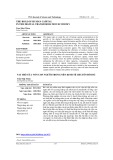
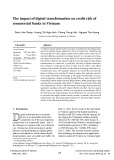
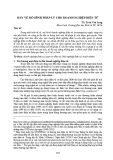
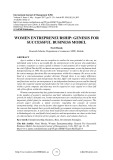
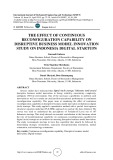












![Bộ câu hỏi trắc nghiệm Đổi mới và sáng tạo [mới nhất]](https://cdn.tailieu.vn/images/document/thumbnail/2025/20251007/kimphuong1001/135x160/56111759828894.jpg)


